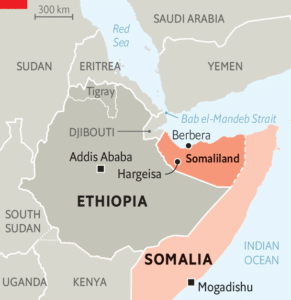Ethiopia’s Port Access: a National Discuss, Regional Consequences, Economic and Sociogeopolitical Stakes
More than three decades after Eritrea’s 1993 independence left Ethiopia landlocked, a once-sensitive topic has re-entered national debate with renewed urgency: how can a country of more than 126 million people continue to grow without direct access to the sea? Prime Minister Abiy Ahmed has elevated the issue from a historical grievance to a national development challenge, arguing that Ethiopia’s future industrialization, trade and regional influence hinge on securing diversified maritime access.
The Ethiopian families’ fallout from being landlocked is not abstract. High import costs raise the price of everyday goods like cooking oil, school supplies, etc., while exporters face logistics delays that can wipe out profit margins across small/big business-mat. The dependence on a single corridor through Djibouti means supply disruptions ripple quickly into household budgets and business planning.
The country’s youth, which makes up more than 70% of the population, feels this crunch most sharply. Factories struggle with export bottlenecks, limiting job creation. Families sending migrant workers or exporting produce must worry about the reliability of corridors far beyond their control. As Ethiopia’s population pushes toward 150 million by 2030, economic pressure is transforming a geopolitical issue into a social one.
![]()
![]()
A long maritime memory meets modern constraints. Ethiopia’s maritime history runs farther back in time than seen or read. The Axumite Empire once commanded influential Red Sea ports like Adulis, and for decades after World War II, the Assab served as the country’s main commercial outlet. That access disappeared after the 1998-2000 border war with Eritrea, leaving Ethiopia almost entirely dependent on Djibouti, which now handles over 90% of its trade. This reliance is expensive, costing over an estimated $1.5 to $2 billion annually in port fees and exposes Ethiopia to political shifts, global shipping disruptions and security threats in the increasingly fragile Red Sea corridor. A regional puzzle with political and cultural layers.
The red sea access debate polarizes public opinion politically. Some see it as a legitimate development priority grounded in international law, while others fear it could inflame regional tensions. Customarily, the narrative touches on collective memory, with Ethiopia as an ancient maritime power and on the trauma of the Eritrea-Ethiopia conflict that severed access in the 1990s.
There are also sensitivities around how Assab became part of Eritrea during Ethiopia’s turbulent political transition. Some Ethiopians question whether the transfer was ever fully ratified; while others argue that reopening old territorial claims risks destabilizing already fragile relationships in horn of Africa. It could mesmerize further the business pressures within the region, and weaken continental opportunities.
Regarding the Ethiopia’s business community, logistics constraints are among the largest barriers to foreign investment. Exporters of coffee, flowers, textiles and leather contend with long transit times, unpredictable container availability and high freight costs. Investors considering Ethiopia as a manufacturing hub often cite the lack of port diversification as a critical risk.

Yet, continental frameworks like the African Continental Free Trade Area (AfCFTA) and the 2050 Africa’s Integrated Maritime Strategy increasingly view landlocked countries as land-linked rather than being seen as disadvantaged. In Ethiopia’s case, aligning its port strategy with these platforms could unlock new financing, partnerships and leverage. Romancing diplomacy over force, could be Ethiopia’s emerging strategy in this course.
International law, including UNCLOS, guarantees landlocked states access to the sea, but leaves the implementation to bilateral cooperation. Ethiopia appears to be embracing this approach, pursuing multiple options in these directions simultaneously: Resetting dialogue with Eritrea to explore access to Assab. Deepening engagement with Djibouti on logistics modernization. Operationalizing its 2024 MoU with Somaliland, despite diplomatic fallout with Somalia. Reviving participation in Kenya’s LAPSSET corridor for Indian Ocean access. Leveraging BRICS, WTO accession and BRI investments to attract port and rail financing.
Comparable models elsewhere, such as from Moldova’s negotiated Danube access to Morocco’s Atlantic corridors for Sahel states, shows that creative diplomacy can produce maritime solutions without territorial confrontation. Driving a consideration of social and regional negotiable issues towards national developmental economy, not just tight-embrace of strategy.

Ethiopia’s push for sea access is often framed as a geopolitical scheme, but at its core it is about development support for human existence and economic transactions. Lowering the cost of food, improving wages, enabling exports, stabilizing supply chains and creating opportunities for millions of young people. At the regional level, fostering cooperation rather than competition could reduce tensions at the horn of Africa, which is already strained by conflict, drought and rising security threats in the Red Sea.
Ethiopia’s landlocked status has become a structural constraint on its ambition to be an industrial, energy and logistics hub. But any lasting solution will require diplomacy, regional integration that will birth a propositive-politics for shared economic benefits.
If Ethiopia can frame sea access as a continental development challenge rather than a bilateral dispute, it may not only secure a maritime outlet, but also contribute to a more stable and interconnected horn of Africa.






